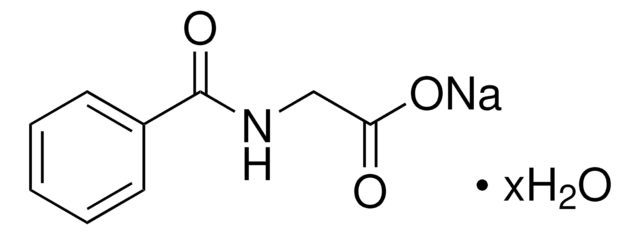B85919
2-Butanol
ReagentPlus®, ≥99%
Synonyme(s) :
Alcool sec-butylique
About This Item
Produits recommandés
Qualité
reagent
Niveau de qualité
Densité de vapeur
2.6 (vs air)
Pression de vapeur
12.5 mmHg ( 20 °C)
Gamme de produits
ReagentPlus®
Essai
≥99%
Forme
liquid
Température d'inflammation spontanée
761 °F
Limite d'explosivité
9.8 %
IVD
for in vitro diagnostic use
dilution
(for general lab use)
Indice de réfraction
n20/D 1.397 (lit.)
pb
98 °C (lit.)
Pf
−115 °C (lit.)
Densité
0.808 g/mL at 25 °C (lit.)
Chaîne SMILES
CCC(C)O
InChI
1S/C4H10O/c1-3-4(2)5/h4-5H,3H2,1-2H3
Clé InChI
BTANRVKWQNVYAZ-UHFFFAOYSA-N
Vous recherchez des produits similaires ? Visite Guide de comparaison des produits
Catégories apparentées
Description générale
Application
- As a precursor to produce 2-butanone in presence of KMnO4 oxidant and CPC (N-cetylpyridinium chloride) micellar catalyst.
- In the production of CH3NH3PbI3 perovskite films.
Informations légales
Mention d'avertissement
Warning
Mentions de danger
Conseils de prudence
Classification des risques
Eye Irrit. 2 - Flam. Liq. 3 - STOT SE 3
Organes cibles
Central nervous system, Respiratory system
Code de la classe de stockage
3 - Flammable liquids
Classe de danger pour l'eau (WGK)
WGK 1
Point d'éclair (°F)
80.6 °F - closed cup
Point d'éclair (°C)
27 °C - closed cup
Faites votre choix parmi les versions les plus récentes :
Déjà en possession de ce produit ?
Retrouvez la documentation relative aux produits que vous avez récemment achetés dans la Bibliothèque de documents.
Les clients ont également consulté
Notre équipe de scientifiques dispose d'une expérience dans tous les secteurs de la recherche, notamment en sciences de la vie, science des matériaux, synthèse chimique, chromatographie, analyse et dans de nombreux autres domaines..
Contacter notre Service technique









